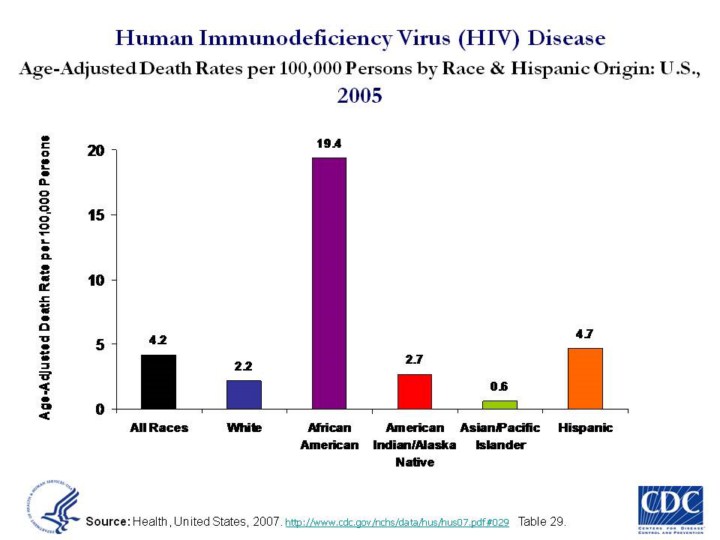| front |1 |2 |3 |4 |5 |6 |7 |8 |9 |10 |11 |12 |13 |14 |15 |16 |17 |18 |19 |20 |21 |22 |23 |24 |25 |26 |27 |28 | 29 |30 |31 |32 |33 |34 |35 |36 |37 |38 |39|40 |41 |42 |43 |44 |45 |46 |47 |48 |49 |50 |51 |52 |53 |54 |55 |56 |57 |58 |review |
 |
Updated 6/2/08 by SB. Age-Adjusted Death Rates per 100,000 Persons by Race, and Hispanic Origin for Human Immunodeficiency Virus (HIV) Disease: U.S., 2002 The HIV/AIDS epidemic is a health crisis for African Americans. In 2001, HIV/AIDS was among the top three causes of death for African American men aged 2554 years and among the top 4 causes of death for African American women aged 2054 years. It was the number one cause of death for African American women aged 2534 years. (18)
According to the 2000 Census, African Americans make up 12.3% of the U.S. population. However, they have accounted for 368,169 (40%) of the 929,985 estimated AIDS cases diagnosed since the epidemic began. During 20002003, HIV/AIDS rates for African American females were 19 times the rates for white females and 5 times the rates for Hispanic females. Rates for African American males were 7 times those for non-Hispanic white males and 3 times those for Hispanic males. (18)
Causes for the Disparity: --According to a recent study of HIV infected and noninfected African American men who have sex with men (MSM), approximately 20% of the study participants reported having had a female sex partner during the preceding 12 months. In another study of HIV-infected persons, 34% of African American MSM reported having had sex with women, even though only 6% of African American women reported having had sex with a bisexual man. --Injection drug use is the 2nd leading cause of HIV infection for African American women and the 3rd leading cause of HIV infection for African American men. -- The highest rates of sexually transmitted diseases (STDs) are those for African Americans. In 2003, African Americans were 20 times as likely as whites to have gonorrhea and 5.2 times as likely to have syphilis. Partly because of physical changes caused by STDs, including genital lesions that can serve as an entry point for HIV, the presence of certain STDs can increase ones chances of contracting HIV by 3- to 5-fold. Similarly, a person who is coinfected has a greater chance of spreading HIV to others -- Studies show that a significant number of African American MSM identify themselves as heterosexual. As a result, they may not relate to prevention messages crafted for men who identify themselves as homosexual. -- Nearly 1 in 4 African Americans lives in poverty. Studies have found an association between higher AIDS incidence and lower income. The socioeconomic problems associated with poverty, including limited access to high-quality health care and HIV prevention education, directly or indirectly increase HIV risk. A recent study of HIV transmission among African American women in North Carolina found that women with HIV infection were more likely than noninfected women to be unemployed, receive public assistance, have had 20 or more lifetime sexual partners, have a lifetime history of genital herpes infection, have used crack or cocaine, or have traded sex for drugs, money, or shelter. (18)
Slide source (9) |